Why would you comply? The case of parking your bike at Leiden University
The Corona era swiftly got us tuned into signs guiding our navigation through public space; arrows told us to keep 1.5 metres distance and in which direction to walk, pictograms informed us how many people were allowed in a certain space and when to wear masks.
The various signs communicating the Covid-19 measures quickly became commonplace, and although the content was sometimes hotly debated, the messaging itself gave less rise for contention (Ratzan, Sommarivac & Rauh, 2020). Of course, regulation of our behaviour in public spaces via directive signs is not new in any way (Barker, 2017). Often, such regulation is standardised and uniformly brought, and we hardly notice it. When we actively register the directive directed at us, generally content tends to elicit more attention than the packaging of the message.
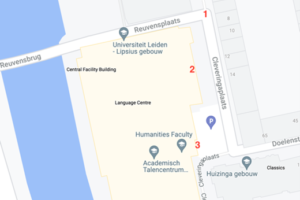

Semi-fixed features in the linguistic landscape
This packaging however is often quite interesting: How is a certain issue communicated? Signs can be analysed as semi-fixed features (Rapoport, 1990) of the linguistic landscape (Blommaert, 2013) that figure in the way a space is produced and in turn produces the sociality taking place in that space (Lefebvre, 1991). In other words – signs contribute to how a space is perceived and experienced, and how people act in that space. A very nice example of how a given directive can be communicated in different ways concerns the parking of your bike at the Lipsius building.
Apparently, Leiden University is encountering a challenge in getting visitors, students and employees to park their bikes in the designated facilities. Walking from Matthias de Vrieshoff to the Kamerlingh Onnes Building on a sunny autumn morning (Wednesday 22 September, to be precise), the passer-by comes across the following three signs. The signs are related in order of their appearance on a 50-metre stretch running from Reuvenplaats to halfway Cleveringaplaats.
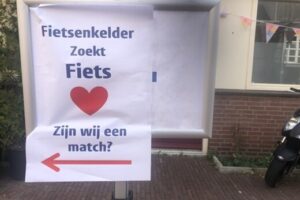

Bike basement seeks bike
The first sign is a temporary structure. A mobile stand commonly used to indicate directions has been set up at the junction of Reuvenplaats and Cleveringaplaats. The information board is A3 sized in landscape layout, and an A3 print has been fabricated, but in portrait layout. In other words: the print does not fit in the signal board as intended. This offers an extra dimension to the question posed on the print, which asks: “Are we a match?” The question however doesn’t pertain to the ill fit of the print, but to the announcement above the bright red heart, stating ‘bike basement seeks bike’. The message has been worded like a classical dating advertisement, and for some probably also rings a bell with the highly popular Dutch television programme ‘Boer zoekt vrouw’. The sign is playful and inviting. This sign can be seen as a nudge to make life simpler, safer, or in this context easier for people to navigate to the appropriate place to stall your bike (Sunstein, 2019).
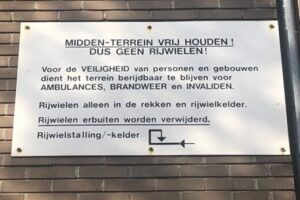

Multiple exclamation points
Subsequently, walking down Cleveringaplaats to the head entrance of the Lipsius building, one encounters an area set apart for bike parking. Fixed to the wall of the Lipsius building is a large sign. The lettering is black on white, in contrast to the blue on white of the print. No bright red heart, but multiple exclamation points. The text informs us that bikes may only be parked in the racks or in the basement; if they are placed anywhere else, they will be removed. Interestingly, this text explains why it is not allowed to park outside the designated locations: for the safety of people and the building, the area needs to remain accessible for ambulances, the fire department and disabled people. An arrow indicates the route to the bike basement. The terminology used in the sign gives the impression that this text dates from a time when the word rijwiel was still in common use and the apparent age of the sign offers makes one wonder about its effectiveness. Whereas there are indications that under certain conditions nudges are effective (Hummel & Maedche, 2019), there is also research indicating the temporality of effects. For example: research into the use of Dick Bruna signs to achieve speed reductions, concluded that these signs only reduced speed for a few weeks (Goldenbeld, de Groot-Mesken & Rijsdijk, 2016).
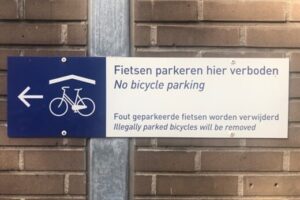

Small and direct
The final sign is the smallest and most direct: it is forbidden to park your bike on this spot. There is no attempt to charm or seduce, and no explanation for the ban is offered. One is warned that illegally parked bicycles will be removed, the only outreach is the arrow pointing in the direction in which shelter for the bike can be found. This brings to mind that in communication it is both about how a message is conveyed and how a message is received. Baldwin (2014) notes that multiple aspects play a role in how communications are received, including factors such as intentions, capacity, and variations of institutional, social, economic and cultural environment.
Connection to compliance and regulation?
The way in which these three signs communicate the same message in such different ways offers an entertaining trigger to think about how compliance can be secured on the regulation to park bikes where they are supposed to be parked. It also offers a more profound trigger to think about larger questions on how such communications shape the public space we share and traverse in, how they inform our perception of a space and how this subsequently structures our behaviour in that space. Compliance and regulation literature clearly indicates it’s not just about the bike; as a certain norm-violating behaviour becomes more common, it can negatively influence conformity with other norms and rules, and this in turn can cause disorder to spread (Keizer, Lindenberg and Steg, 2008). Whereas creating effective behavioural recommendations that reduce noncompliance is a challenge, obtaining compliance with behavioural recommendations is perhaps an even greater challenge. Considering these three consecutive signs en route from Reuvenplaats to Leiden Law School presents the opportunity to contemplate larger compliance puzzles from a very personal perspective: When you consider these three signs, what do they convey to you? Which of these signs would prompt you to comply, and why?



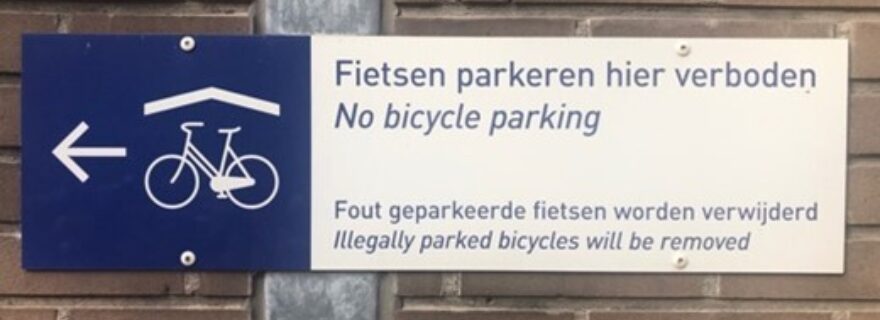
0 Comments
Add a comment